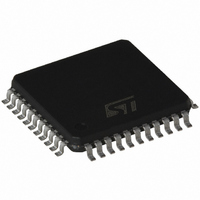TDA7406TR STMicroelectronics, TDA7406TR Datasheet - Page 37

TDA7406TR
Manufacturer Part Number
TDA7406TR
Description
IC PROCESSOR CAR SIGNAL 44-TQFP
Manufacturer
STMicroelectronics
Type
Car Signal Processorr
Datasheet
1.TDA7406TR.pdf
(64 pages)
Specifications of TDA7406TR
Applications
Automotive Systems
Mounting Type
Surface Mount
Package / Case
44-TQFP, 44-VQFP
Lead Free Status / RoHS Status
Lead free / RoHS Compliant
Available stocks
Company
Part Number
Manufacturer
Quantity
Price
Company:
Part Number:
TDA7406TR
Manufacturer:
STMicroelectronics
Quantity:
10 000
TDA7406
8.4
8.5
8.6
8.7
8.8
De-emphasis and Highcut
The de-emphasis-lowpass allows to choose a time constant between 37.5 and 100µs. The
highcut control range will be 2 x τ
constant (see programming section). The bit D7 of the hightcut-byte will shift time constant
and range.
Inside the highcut control range (between VHCH and VHCL) the LEVEL signal is converted
into a 5 bit word which controls the lowpass time constant between τ
Thereby the resolution will remain always 5 bits independently of the absolute voltage range
between the VHCH- and VHCL-values. In addition the maximum attenuation can be fixed
between 2 and 10dB.
The highcut function can be switched off by I
The setup of the highcut characteristics is described in
PLL and Pilot tone-Detector
The PLL has the task to lock on the 19kHz pilot tone during a stereo-transmission to allow a
correct demodulation. The included pilot tone-detector enables the demodulation if the pilot
tone reaches the selected pilot tone threshold V
available. The detector output (signal STEREO, see Block diagram) can be checked by
reading the status byte of the TDA7406 via I
into “Hold”-mode which freezes the PLL's state (bit D
Softmute the PLL will again follow the input signal only by correcting the phase error.
Fieldstrength Control
The fieldstrength input is used to control the highcut- and the stereoblend-function. In
addition the signal can be also used to control the noiseblanker thresholds and as input for
the multipath detector. These additional functions are described in sections 5.3 and 6.
LEVEL-Input and -Gain
To suppress undesired high frequency modulation on the highcut- and stereoblend-control
signal the LEVEL signal is lowpass filtered firstly. The filter is a combination of a 1.st-order
RC-lowpass at 53kHz (working as anti-aliasing filter) and a 1.st-order switched-capacitor-
lowpass at 2.2kHz. The second stage is a programmable gain stage to adapt the LEVEL
signal internally to different IF-devices (see Testmode section 5: LEVELHCC). The gain is
widely programmable in 16 steps from 0dB to 6dB (step=0.4dB). These 4 bits are located
together with the Roll-Off bits in the “Stereodecoder-Adjustment”-byte to simplify a possible
adjustment during the production of the car radio. This signal controls directly the Highcut
stage whereas the signal is filtered again (fc=100Hz) before the stereoblend stage (see
Figure
Stereoblend Control
The stereoblend control block converts the internal LEVEL-voltage (LEVELSB) into an
demodulator compatible analog signal which is used to control the channel separation
26).
Deemp
or 2.7 x τ
2
2
C-bus. During a Softmute the PLL can be set
C-bus (bit D7, Highcut byte set to “0”).
Functional Description of Stereodecoder
PTHST
Deemp
4
. Two different thresholds are
, Softmute byte). After releasing the
Section
dependent on the selected time
8.9.
Deemp
...3 (3.7) x τ
Deemp
37/64
.













